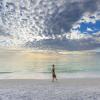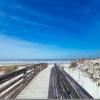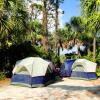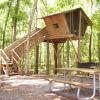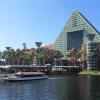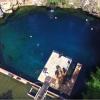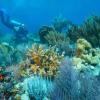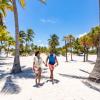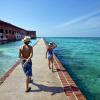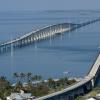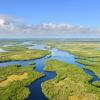Glossary of Florida Terms for International Visitors
Check out this list of terms frequently used in the Sunshine State before your Florida vacation.
FOOD
Catfish: While there are several types of Florida catfish, they are all easily recognised by the wiry appendages around their mouths that resemble a cat's whiskers. The channel catfish is considered the one of the best-eating freshwater fish and has sweet white, tender meat.
Citrus: Florida is not only known for its sun-ripened oranges, but also tangerines, grapefruits, lemons and limes. Enjoy these luscious juicy fruits plain or creatively prepared as a tangy seafood sauce, savoury salsa or tropical-flavoured ice cream.
Conch Fritters: Conch (pronounced “konk”) is an edible marine snail or mollusc found in warmer waters. Conch meat has a mild, sweet clam-like flavour and is commonly ground and mixed with spices, shaped into balls and fried in a batter to make “fritters.” It is also served in a tomato-based conch chowder and marinated raw in conch salad. Conch fritters and other conch concoctions are most popular in South Florida and especially the Florida Keys.
Cuban Sandwich: This tasty, toasted sandwich is a favourite meal in South Florida, where many Cuban immigrants settled in the early 20th century. It’s made with sliced pork, ham, Swiss cheese and pickles in buttered Cuban bread, then heated and flattened with a sandwich press.
Datil Pepper: Hot, hot hot! The Minorcans migrated to St. Augustine in 1777, bringing with them the seeds of their datil pepper, one of the most potent on the planet. Today it remains a key ingredient in St. Augustine area cuisine.
“Floribbean” Cuisine: Florida’s melting pot of cultures has resulted in this sumptuous hybrid cuisine, a combination of Caribbean and Latin American flavours, classic American and European traditions, fresh Florida produce and the Sunshine State’s specialties of the sea.
Florida Largemouth Bass: Perhaps the most famous type of black bass, this is not only Florida's most popular freshwater game fish and the state freshwater fish, but also a mouth watering catch. The meat is white, flaky and low in oil, and best prepared fried or baked.
Florida Lobster: This warm water crustacean is also called spiny or rock lobster. Unlike its New England counterpart, it has no claws, so most of its succulent meat is in the tail.
Grits: Similar in texture to pudding, grits are dried, ground and hulled corn kernels, boiled and served with eggs as part of a good, old-fashioned Southern breakfast. Salt, pepper and butter enhance the flavour and compliment the eggs. Grits mixed with cheese (“cheese grits”) are classic Southern dinner fare along with fried fish and hush puppies (see below).
Grouper: A firm white fish delicious barbecued, blackened or fried in strips called grouper fingers. A fresh grouper sandwich is a favourite of Floridians and visitors alike.
Gulf Shrimp: Our Gulf of Mexico shrimp is tender and sweet. Shrimp cocktail, shrimp scampi or tequila lime shrimp, you’ll find it served however you like.
Hush Puppies: These crunchy torpedo-shaped cornmeal fritters are a Southern tradition and are typically served at lunch or dinner with fried fish, oysters, shrimp or scallops.
Key Lime Pie: Key limes, a tiny, tart, yellow variety from the Florida Keys, are what give Key Lime Pie that sunshine and tropical breeze taste. Don't be fooled by imitations; real Key lime pie is yellow, not green!
Mahi Mahi: Also known as Dorado or dolphin fish (not to be confused with a porpoise), mahi mahi is a lean, sweet fish. You’ll enjoy it seared, baked or barbecued.
Rock Shrimp: A succulent, delicate shrimp from the Gulf of Mexico waters. Rock shrimp is a deep-water cousin of pink, brown and white shrimps, but is smaller, cooks faster and has a lobster-like flavour.
Snapper: Florida snapper makes for tasty fillets prepared in a variety of ways: pan-seared, crab-stuffed, cashew-encrusted, barbecued, baked or grilled. Firm, sweet and succulent, its flavour inspires endless recipes and culinary presentations.
Stone Crab Claws: Florida’s stone crabs are de-clawed and returned to sea, preserving a bountiful supply of claws. Stone crab claws are a celebrated seasonal delicacy available from October through May.
ANIMALS
Alligator: The alligator is the official state reptile, averages 1.8 metres to 3.6 metres in length and can sprint with blurring speed. Alligators can be safely spotted at many of our parks and wildlife refuges. Keep a safe distance from these animals.
Anhinga: Nicknamed “the snake bird,” this enigmatic creature swims with its body submerged, revealing only its head and long snake-like neck above water. It uses its yellow pointed beak to stab fish as it swims underwater in rivers, swamps and marshes.
Armadillo: If at night you hear a sound like an elephant crushing palmetto fronds underfoot, chances are it’s a 2-kg armadillo. Armadillos look like tiny dinosaurs, and thousands of years ago stood just over 1 metre tall and weighed about 270 kg. (These days mature armadillos only grow to 38 to 43 cm long, not including their tail, and weigh 3.5 to 8 kg.)
Bald Eagle: A national symbol since 1782, this true American bird is the only eagle unique to North America. The southern variety favours feathering its nest in Florida — The Prairie Lakes Unit of Three Lakes Wildlife Management has the highest concentration of nesting bald eagles in the lower 48 states.
Bobcat: Named for their short or “bobbed” tail, these fascinating felines are larger than house cats and sport razor sharp teeth and claws. The bobcat prefers woody or grassy areas, but can be seen along deserted roads at dawn and dusk hunting for small rodents.
Crocodile: Crocodiles have narrower snouts than alligators, grow slightly larger and shy from human contact. The rare, prehistoric animal lives in the Everglades and in the Upper Keys.
Dolphin: Dolphins are warm blooded, air-breathing mammals with communication skills and social style. They wear a perpetual smile and playfully frolic alongside fast moving boats. See them from our shores or by boat from Pensacola to the Florida Keys. The dolphin is the state saltwater mammal.
Double-crested Cormorant: Similar in appearance to the anhinga, the cormorant is related to the pelican and prefers saltwater to fresh water. Its throat pouch can expand to accommodate a 30-cm long fish! These amazing birds can dive to 30 metres and stay under water for more than a minute.
Flamingo: It’s hard to imagine Florida without flamingos; they are even the symbol of the state lottery. But the truth is there’s a better chance of seeing the plastic variety on a lawn than the real bird in the wild. You will see plenty at our state parks, sanctuaries and zoos, where the non-Florida natives have found happy homes.
Florida Black Bear: This black beauty has curved claws for climbing the trees of our national forests. Black bears eat honey, honeybees, fruits, nuts, twigs and small animals. See them safely from the boardwalk at Corkscrew Swamp Sanctuary in Naples. Keep a safe distance from these animals and never feed them.
Florida Panther: Florida’s state animal, this cool cat is actually a cougar subspecies. Though shy and seldom seen, panthers are usually found in the pinelands, hardwood hammocks and mixed swamp forests of the Everglades and adjacent wildlife refuges, including the Florida Panther National Wildlife Refuge in Naples.
Florida Sandhill Crane: This big bird stands several feet tall and has a hauntingly beautiful call. A non-migratory resident, it can be found in both urban and rural areas. Sandhill cranes mate for life and live to about 30 years old.
Florida Scrub Jay: The Florida scrub jay is the only species of bird found strictly in the Sunshine State. About 30-cm long from head to tail, its crestless head is blue, and so are its wings and long, loose tail feathers. It is federally protected and can be sighted at state parks, forests and wildlife refuges.
Gopher Tortoise: Gopher tortoises look similar to sea turtles, but they can’t swim… do not “return” them to water! They are the only tortoises native to this country, and the only tortoise found in Florida. The burrows they dig in sandy soils are used by more than 350 species of animals, including opossums, rabbits and snakes.
Great Blue Heron: Long-necked, lanky and large, this regal bird grows to 1.2 metres tall
with a 1.8-metre wingspan. It uses its great bill to spear fish, frogs and snakes in rivers, marshes and lakes. Not only is it blue, but its eggs are, too.
Horse Conch: Also known as the giant band shell, the horse conch is Florida’s state shell. It is native to the marine waters around Florida and can grow to a length of 60 centimetres. Its orange-tinged shell acts as an external skeleton of the soft-bodied animal that inhabits it.
Key Deer: From a distance you might mistake these tiny deer for dogs, as they weigh just 40 kg and are only 75 centimetres tall. Most key deer live in the endangered hardwood hammocks of Big Pine Key’s National Key Deer Refuge, but they are also visible throughout surrounding Keys. They are mostly active at dawn and dusk.
Manatee: Also called “sea cows,” these gentle vegetarians grow to 3 metres long, weigh 450 kg and are related to the elephant. Manatees head for warm waters in winter and can be seen in rivers, inlets, springs and near power plants. The manatee is the state marine mammal. When boating, observe “no wake” zones and if on a swimming or snorkelling tour with the animals, be sure to obey rules regarding contact with them.
Mockingbird: Florida's state bird is the mockingbird. It lives here year ‘round and is known for imitating or "mocking" the songs of other birds. Its Latin name means "mimic of many tongues".
Northern Right Whale: The grand sight of a whale splashing in the water is not usually associated with Florida. But northern rights choose our northeastern coastal waters, almost exclusively, to give birth in winter months. They are among the most endangered species of large mammals in the world.
Opossum: Florida's only marsupials, opossums are about the size of a house cat, have long naked tails, small ears and pink noses. If threatened, they may go limp and appear dead, hence the term, "playing possum". They are common in residential and suburban areas, and are mostly active at night.
Osprey: Aptly called “fish hawks”, these birds of prey can be found wherever there are fish. They are such expert anglers that centuries ago it was thought they simply cast a spell that caused the fish to go belly-up. The osprey is easily recognised by its impressively long wingspan and white under parts.
Pelican: The pelican has a large throat pouch that actually holds three times more fish than its stomach. These robust birds live at our beaches and waterways and at the Pelican Island National Wildlife Refuge at Vero Beach.
Roseate Spoonbill: Florida’s “real” pink bird has a brilliant fuchsia body with a bright red shoulder patch and a long, flat bill with rounded, spoon-like end. This pretty native occurs largely in South Florida.
Sailfish: The state saltwater fish, the sailfish resembles a torpedo when swimming and can reach speeds of 95 km/h. Size and weight taken from Florida waters is up to 2 metres and 50 kg. In 1934, Florida author Ernest Hemingway (see “Historical Figures” below) caught a 2.8-metre sailfish off Key West.
Sea Turtle: Sea turtle moms migrate great distances to return to nesting sites on both coasts of Florida, though most are located from Titusville to Sebastian Inlet. The Archie Carr National Wildlife Refuge, stretching from Melbourne Beach to Wabasso, has the densest population of nesting sea turtles in the Western Hemisphere.
Sharks: Florida is home to a variety of shark species, including nurse, lemon, hammerhead, and bull. sharks Most species are not aggressive to humans and will shy away from contact. Reduce your chances of having an interaction with a shark by swimming close to shore, avoiding wearing shiny jewelry, and avoiding the water during darkness or twilight.
PLANTS
Australian Pine: The towering pines that grace many of Florida’s beaches and coastal areas provide a romantic backdrop and refreshing shade. Unfortunately, they are non-natives, or “exotics”, brought here in the late 1800’s, that negatively impact native flora and fauna. As such, they are banned from cultivation.
Azalea: Spectacular flower masses and colours, plant form and evergreen foliage make azaleas a popular plant for landscaping. Azaleas thrive throughout Florida except in the southern tip of the state. Clusters of bright blooms appear in the fall in southwest Florida; in central and north Florida you’ll see them from winter through spring.
Bougainvillea: This tropical vine flourishes in the southern half of Florida and is ablaze with colour almost all year round, particularly in winter and spring. Its flowers can be bright fuchsia, deep magenta, vermilion or white. Bougainvillea is also known as the paper flower.
Epiphytes: Epiphytes grow on the branches, trunks and leaves of trees and include orchids, cacti, bromeliads, mosses and ferns. They need only air and rainfall for nourishment.
Frangipani: Also called plumeria or temple tree, frangipani has intensely fragrant, spiral-shaped blooms that appear spring through fall. Growing no more than 6 metres tall, the flowers of these enchanting little trees are known worldwide for their use in Hawaiian leis.
Hibiscus: These tropical beauties have brilliant blooms in an array of colours. Most common are scarlet, yellow and orange, but there is a broad range of colour combinations and shades. Although individual flowers usually last only a day or two, the flowering season lasts nearly all year long.
Gumbo Limbo: This beautiful native tree has featherlike leaves and an attractive shiny red exfoliating bark. Fast growing and salt-tolerant, it thrives with little or no care. In South Florida, the gumbo-limbo is called “the tourist tree” because of its red, flaking skin, a not-so-subtle reminder to visitors to apply sunscreen on a regular basis!
Live Oak: One of the trees most associated with the South, especially when draped in Spanish moss (see below). These magnificently large shade trees can grow 15 metres tall with a branch spread of more than 45 metres. Slow growing but long-lived, live oaks comprise most of Florida’s historic trees; some are as many as 300 years old. Live oak acorns provide a flavourful meal for birds, squirrels and other animals.
Longleaf Pine: A tall, stately evergreen tree with long slender pine needles. Longleaf pines can grow to 30 metres and live for hundreds of years. They once covered millions of hectares, but land development, invasive plants and other factors greatly reduced their range; however, reforestation efforts promise more of these majestic trees in the future.
Magnolia Tree: The leaves of this evergreen tree are as attractive as its showy white flowers; they are long, leathery and dark glossy green with rusty, velveteen undersides. Its fragrant blooms are pretty as a picture and appear in spring and summer. The tree can grow 20-30 metres tall with a trunk of 60-90 centimetres in diameter.
Oleander: The oleander is a flowering shrub or small tree with long, dark green leaves and an abundance of single or double, sometimes fragrant flowers in shades of white, pink, red or yellow. Great swaths of hardy oleander line many of Florida’s roads and highways and provide a soothing display to enjoy while driving.
Orange Blossom: A waxy white flower with an exquisite fragrance, the orange blossom is the state flower. Millions of these flowers perfume the air in Central and South Florida each spring when orange trees are in bloom.
Red Mangroves: Of the three types of mangroves that grow in Florida, the red mangrove is the most well known. It typically grows along the water's edge and is easily identified by its tangled, reddish roots. These roots have earned mangroves the title, "walking trees", as they appear to be standing or walking on the surface of the water.
Sabal Palm: Florida’s state tree, this tall, graceful palm grows in any type of soil and is found throughout the state. It is also called a cabbage palm because it is sometimes harvested for tender hearts of palm, a tasty artichoke-like vegetable served in salads.
Saw Palmetto: A hardy fan palm that can grow in clumps of 6 metres or more in diameter, the saw palmetto is found on sites ranging from seaside sand dunes and dry scrub to pinelands, hammocks, moist forests and wetlands.
Sea Grapes: This native, salt-tolerant plant grows on many of Florida’s beaches and helps to stabilise sand dunes. It has thick round leaves and produces clusters of grape-like fruit consumed by a number of birds and mammals. Its protective canopy provides habitat for animals such as songbirds, lizards, gopher tortoises and sea mice.
Sea Oats: Sea oats are wispy, silky-stalked plants found along the Atlantic and Gulf coasts. They are the most common of grassy dune plants and help protect Florida’s beach dunes from erosion.
Spanish Moss: The greyish lacy clusters you see gracefully draped from oak trees are air plants, or epiphytes, known as Spanish moss. They receive their nourishment from the air and rain, not the trees.
Yellow Alamanda: A rambling vine and prolific bloomer, the yellow alamanda displays big, bright yellow flowers. Look for it cascading over garden walls or fences. It is also referred to as golden trumpet, angel’s trumpet or buttercup flower.
HISTORICAL FIGURES
Addison Mizner: Addison Mizner changed the face of Florida architecture by introducing a mix of Spanish and Italian styles known as Mediterranean Revival. His houses, hotels and clubs set the style for Palm Beach and Boca Raton, and, over the years influenced others to create the romantic arches, stucco exteriors, front porches, red tiles and flowered courtyards we see throughout the state today.
Andrew Jackson: As a general in the U.S. military, Andrew Jackson led troops into Florida in 1812 to destroy the peaceful Indian towns and Afro-American settlements in Alachua County. He launched the First Seminole War in 1817, burning Seminole villages and capturing St. Marks and Pensacola. As president, he was responsible for the “Indian Removal Act” of 1830, forcing out or killing all but a small, determined group of Native Americans whose descendants maintain reservations in Florida today. (See “Miccosukee Tribe” and “Seminole Tribe” below.)
Ernest Hemingway: One of America’s great adventurers and writers, Ernest “Papa” Hemingway penned many of his works from his home in Key West. His works are considered classics of American literature and include For Whom The Bell Tolls, To Have and Have Not and The Old Man and the Sea, for which he won the Pulitzer Prize. His Key West mansion, lush grounds and “pet fountain” now comprise a must-see museum that is also home to about 60 cats, many descendents of his original six-toed felines.
Henry Flagler: A key figure in the development of the east coast of Florida and particularly St. Augustine, Flagler organised the Florida East Coast Railway, which extended the railroad south from Daytona through Palm Beach to Key West. He established steamship lines, dredged the Miami harbour and built palatial hotels. He also made anonymous gifts to build schools, churches and hospitals. Flagler invested more than $40 million in Florida and, more than any other, was responsible for its growth.
Hernando de Soto: Hernando de Soto was a Spanish conquistador who explored Florida and the southeastern United States in search of gold and silver. In 1539 he landed on the west coast with 600 troops, servants and staff, 200 horses, and a pack of bloodhounds. From there, the army set about subduing the natives and seizing valuables. De Soto died without finding the riches he sought.
Jose Gaspar: Jose Gaspar, or “Gasparilla”, as he called himself, was one of the most notorious pirates to pillage the west coast of Florida. His undiscovered treasure is supposedly buried on and off its shores. Captiva Island was named for the women he kept captive there, and Tampa holds the annual Gasparilla festival, which includes an exciting re-enactment of the fearless pirate’s invasion.
Marjorie Kinnan Rawlings: Mrs. Rawlings wrote the Pulitzer Prize-winning novel The Yearling and several other important books about the early days of Florida. She is considered one of the state’s finest writers. Her 27.5-hectare estate at Cross Creek is a microcosm of the country, culture and Cracker architecture that typifies Old Florida (see “Miscellaneous” below). It is listed on the National Register of Historic Sites.
Miccosukee Tribe: The Miccosukee and Seminole (see below) Indians were among the first to settle in Florida in the 1700s. Continually forced to scatter to different areas of the state, the Miccosukees are today a small but thriving community living on three reservations in and around the Everglades. Visit The Miccosukee Village in the heart of the Everglades to learn about the tribe’s history, culture and lifestyle through craft demonstrations, a museum tour, airboat rides and more.
Ponce de Leon: Florida owes its name to this Spanish soldier and colonial governor. He was the first European to see the peninsula during Easter time in 1513 and named it “La Florida” in honour of the Spanish Easter celebration, “Pascua de Florida” (feast of flowers). Ponce de Leon explored the entire state in search of the legendary Fountain of Youth, and supposedly found it in St. Augustine.
Seminole Tribe: The Seminole Indians of Florida are descendants of just 300 who managed to elude capture by the U.S. army in the 19th century. Today, more than 2,000 Seminoles live on six reservations in the state, located in Hollywood, Big Cypress, Brighton, Immokalee, Fort Pierce and Tampa.
GEOGRAPHY
Alligator Alley: Alligator Alley (also called Everglades Parkway) is the nickname for the section of Interstate 75 that runs from Naples on the west coast of Florida to near Fort Lauderdale on the east. Much of the highway traverses the Everglades, and alligators often frequent the waterways beside the road.
Bays and Inlets: A bay is a body of water that is partially enclosed by land, but with a wide mouth affording access to the sea, such as Tampa Bay, Biscayne Bay and Matanzas Bay. An inlet is a small bay or a narrow strip of water running into land or between two islands, such as Jupiter Inlet, Ponce de Leon Inlet and Venice Inlet.
The Big Bend: Also known as Middle Florida, The Big Bend includes the ten counties lying between Florida’s two largest rivers, the Apalachicola to the west and the Suwannee to the east.
Cultural Coast: Sarasota County in Southwest Florida has a thriving cultural calendar that includes ballet, symphony, theatre and opera as well as countless art galleries and numerous museums, including the famous John and Mable Ringling Museum of Art. Sarasota is also known as the Cultural Capital of Florida.
Emerald Coast: The deep emerald green waters of the northern Gulf of Mexico along Destin, Fort Walton Beach and Okaloosa Island provide a stunning contrast against its sugar white beaches.
First Coast: Home of St. Augustine, the oldest city in the United States, The First Coast runs just south of Georgia from Fernandina Beach down to Ormond Beach, and includes the picturesque seaside village of Amelia Island.
Gold Coast: The area from Fort Lauderdale to Miami is known as The Gold Coast, and glitters with movie stars, musicians and other members of the rich and famous. With sunny beaches, world-class shopping and sizzling nightlife, these cities sparkle with exciting things to see and do.
Intracoastal Waterway (ICW): A system of artificial and natural channels and canals providing sheltered passage for commercial and leisure boats. The Florida ICW runs the length of the state on both Gulf and Atlantic Coasts, and is a delightful vantage point from which to explore seaside communities by boat.
Key: A low, offshore island composed largely of sand or coral; also called a “cay”. Both names are derived from the Spanish word “cayo”.
Nature Coast: Portions of the Big Bend (see above) and some points south are part of an area called the Nature Coast, so-named for its abundance of wildlife and natural areas from Bayonet Point through Homosassa Springs and Crystal River to Steinhatchee. Outdoor recreation includes golf, snorkelling, swimming, canoeing and fishing in lakes, rivers and the Gulf of Mexico.
Overseas Highway: The Overseas Highway is the southernmost leg of U.S. Highway 1. It links the Florida Keys together with a series of bridges that afford expansive views of natural beauty and wildlife, brilliant sunrises and stunning sunsets.
Panhandle: Northwest Florida, often referred to as the Florida Panhandle, includes the 16 westernmost counties of the state and the cities of Tallahassee (the state capital), Pensacola and Panama City.
Space Coast: The Space Coast runs just south of Ormond Beach to Vero Beach on Florida’s east coast, encompassing Daytona Beach, Cocoa Beach, Canaveral National Seashore, Merritt Island National Wildlife Refuge and Cape Canaveral, home of The
Kennedy Space Centre Visitor Complex.
Sun Coast: While this term describes all of Florida’s sparkling shores, it specifically refers to the 20 barrier islands in the Clearwater/St. Petersburg area of central west Florida. The Sun Coast includes Fort De Soto Park, recently named the top beach in North America by expert coastal geologist, Stephen Leatherman, also known as “Dr. Beach”.
Tamiami Trail: Tamiami Trail is the name for U.S. Highway 41 in Florida, a 437-kilometre stretch that runs north and south connecting the cities of Tampa and Miami. Residents often simply refer to it as “The Trail”.
The Keys: Refers to the Florida Keys, a string of islands off the southeast Florida peninsula from Key Largo south to Key West.
Treasure Coast: Florida’s Treasure Coast stretches from Vero Beach in the north through Boca Raton in the south and covers the counties of Martin, St. Lucie, Indian River and Palm Beach. The name refers to gold-laden Spanish galleons believed to have sunk off the coast during the 17th and 18th centuries. Valuable artefacts from these ships are still being recovered today, both by amateur and professional treasure-hunters.
MISCELLANEOUS
Beach Flag System: Coloured flags on Florida beaches are designed to promote safety by warning beachgoers of water conditions. Blue or green represents calm waters and safe swimming; yellow means mild hazards, including light surf or currents; red warns of highly hazardous conditions; a double-red flag indicates the waters are closed to the public; and purple means marine pests present, which might include jellyfish, stingrays or dangerous fish. The absence of a flag does not necessarily mean the water is safe. Check with a lifeguard to be sure.
Conch: A conch (pronounced “konk”) is not just a meaty marine mollusc (see “Food” above), but also the term used to describe a native resident of Key West.
Cracker: A term that references the state's early settlers, who cracked long whips to herd cattle and oxen. Today it refers to a Florida resident who was born here.
Cracker Architecture: A style created by the first homesteaders of 19th century Florida that evolved over time from a one-room wooden structure to multiple rooms and structures separated by a “dogtrot” or breezeway. Cracker homes have high ceilings, tin roofs, shady porches and plenty of windows to take advantage of cool breezes.
Fire Ants: Large red ants that bite! They create mounds of soil where they make their nests. Do not step on the mounds or you will disturb the ants who will, in turn, disturb you! However, if you leave them undisturbed they are not aggressive.
Green Flash: A burst of emerald green light that can appear on a cloudless horizon at the beginning of sunrise and end of sunset. It is called a “flash” because it only lasts a few seconds.
Gulf Stream: The Gulf Stream is a swift moving warm ocean current that originates off the coast of south Florida in the Gulf of Mexico. As it continues east, it forms the North Atlantic Current, bringing to northwest Europe the balmy temperatures that cause flora and fauna to flourish.
Mosquitoes: These annoying little creatures thrive in heat and humidity and can be out en force in rainy, summer months. Wear insect repellent on your clothes as well as your skin when you're outdoors.
No-see-ums: Also known as sand flies, these tiny biting insects thrive in coastal areas, especially in summer months. They are called no-see-ums because they are barely visible, so small that they can fly right through the tiny holes in a screened door or window. Don’t worry, they won’t “bug” you as long as you wear insect repellent.
Old Florida: A term used to describe Florida before theme parks, holiday flats and other commercial development. Old Florida still exists in the state’s small towns and sleepy fishing villages, vast areas of wilderness and naturally beautiful state parks. It also encompasses simple pleasures like watching sunsets and paddling peaceful rivers.
Sandspurs: Seeds of the sandspur plant that resemble little spiked balls. They thrive in grassy or sandy areas; wear shoes to avoid feeling the sting of their prickly thorns.
Snowbird: Anyone who lives here part-time to escape the cold and snow in other parts of the country, like a bird migrating south in winter. Snowbirds are usually here from November to April, or Thanksgiving through Easter; a period of time referred to as “season”.
Stingray Shuffle: Shuffle your feet as you venture into the Gulf waters, and you’ll avoid injury resulting from inadvertently stepping on a bluntnose stingray. The rays bury themselves in shallow waters near the shore and are not aggressive, but will attack when threatened. Doing the “stingray shuffle” alerts them to swim away, keeping them – and you – safe from harm.
Turtle Walk: A turtle walk or turtle watch is a state-organised nighttime event, usually held in June and July, when the public can view sea turtles nesting and hatching on our shores. For turtle walk schedules, visit http://myfwc.com/seaturtle/.
Victorian/ Gingerbread Architecture: An elaborate style encompassing a number of Victorian era architectural influences – Queen Anne in particular – prevalent in Key West. Here you’ll see homes in vibrant colours; some with turrets, fish scale siding, pitched roofs and the ornate, handcrafted trim referred to as “gingerbread”.
Y’all: Used when addressing more than one person, this contraction of “you all” is a friendly Southern expression, as in, “y’all come back!”
